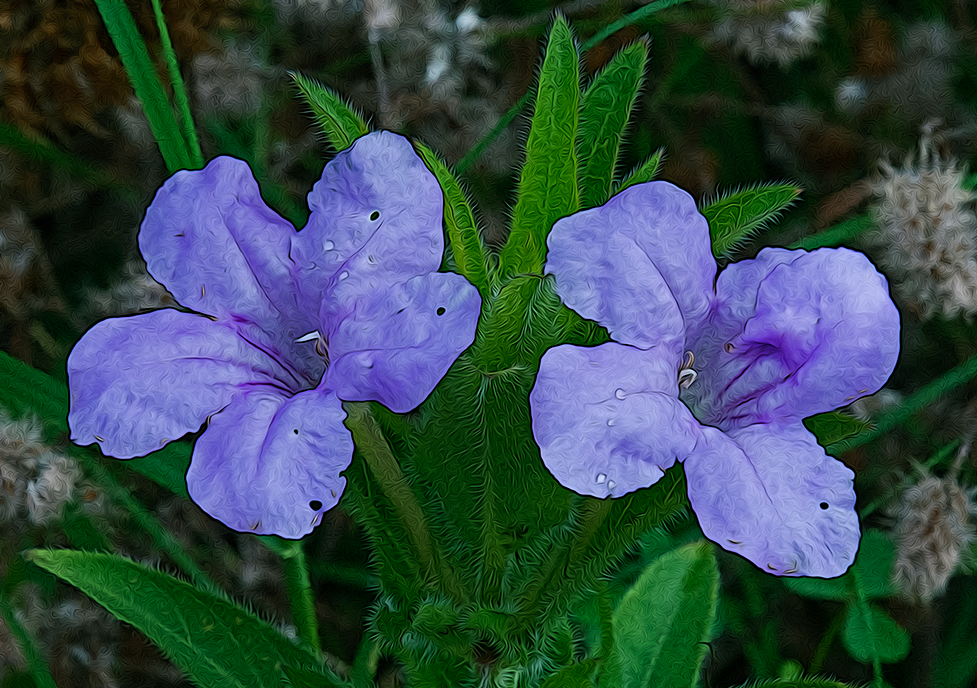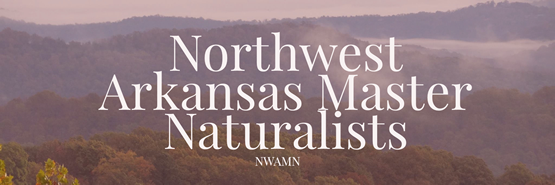

A Comely Pair in the Prairie Wild
Clinging low to the Earth, almost hidden amongst the taller grasses and perennials, the Wild Prairie Petunia aka the Hairy Ruellia aka the Fringeleaf Wild Petunia lends dramatic swirls of color to the tallgrass prairie landscape. In Texas, the Lady Bird Johnson Wildflower Center prefers the scientific name Ruellia humilis to denote the twin specimens shown here — and that's just fine with us. Ruellia ciliosa var. longiflora is also acceptable — so we are told.
Cedar Prairie | Pocola, Oklahoma
Image by Ebenezer | 29 June 2019
The Wild Prairie Petunia
Buckeye Banquet Tables
And Faint Perfumes of Ruellia
By Ebenezer Baldwin Bowles
29 July 2019
They've many common names and quite a few botanical variations on the theme Ruellia, but for sure they're all wild petunias, these violet and blue beauties presently gracing the tallgrass prairies of the Ozark Highlands and Arkansas River Valley.
We've chosen the Wild Prairie Petunia as our favored name, though the objects of our imagery tonight are better known by botanists as “smooth” and “hairy.” That's the charm of common names — we can choose according to fancy, well aware that a friend might know the object of desire by another appellation.
Here at the cottage, we very much admire petunias, though our success in nurturing store-bought specimens all the way through to the end of the growing season is spotty at best. In the wild, petunias succeed on their own — and quite well, thank you.
Let the Roses Wait We Must
Frankly, the appearance of wild petunias on our desktop this week caught us by surprise, though only mildly. We've been thinking mightily about another wildflower, the White Prairie Rose, an Ozark Highlands rarity spotted by renowned Arkansas naturalist Theo Witsell on June 29 during a tour of four tallgrass prairies south of here in the River Valley.
I was lucky enough to be there with Theo and a dozen other explorers to capture a couple of images of the shy White Prairie Rose — thanks, Steve Patterson, for organizing the tour in celebration of the bicentennial of Thomas Nuttall's travels into the Arkansas Territory in 1819. Alas, our tale about Rosa foliolosa remains a work in progress. I promise, cross my heart and hope to sigh, to bring her to fruition before the rising of the Full Sturgeon Moon.
Meanwhile, itching to bring something to the finish line, I turn this evening away from the wild rose and toward the wild petunia, a worthy substitute for casual summertime study.
Much like the meandering paths me and my fellows follow while walking o'er prairie lands in search of form and color in flora and fauna, tonight's meditation on the wild petunia will be unpredictable and maybe a bit eclectic. She's a deeply studied flower the world over, this wild petunia and her distant cousins from the hothouse, so I offer nothing new under the sun. But I did see several. Here goes.

Smooth Ozark Native
Not detecting any hairs protruding from the stems and leaves, I'll surmise that this specimen is the Smooth Wild Petunia, Ruellia strepens of the Acanthus family. Science expresses botanical baldness as “glabrous,” a term so interesting I couldn't resist sharing it. You can also call this sweet little gem a Limestone Ruellia — and, if you want to be the smart nerd in the conversation, try Dipteracanthus micranthus, though I wouldn't recommend it.
Woolsey Wet Prairie | Fayetteville, Arkansas
Image by Ebenezer | 19 July 2019
Punjab Petunias
It was growing late.
The sun sent its picture of the shisham-trees
to decorate the blank side wall of the house;
the wilderness of wild petunia,
usurping
the place of the fast-yielding English annuals,
began to send out
a faint perfume.
—from The Five Rivers by Flora Annie Steel | William Heinemann Publishers London | 1893
Citizen of the World
Sail the Seven Seas and you, or some other intrepid naturalist, will find, upon making land, a petunia somewhere in the wild.
Although she isn't native to India, the diminutive flower arrived there early during British occupation and is considered a welcome guest today. Petunias appeared a century ago on a page of English fiction about India as the source of “faint perfume” in one of Flora Annie Steel's short stories, “Shah Sujah's Mouse,” which we quote above.
Flora Annie's stories are rooted in the Punjab, land of the Sikhs to the far north of the subcontinent, where the five tributary rivers of the Indus flow. Prolific and popular, Flora Annie lived with her imperialist husband in British India for twenty-two years, writing with unusual cultural sensitivity about the domestic life of the indigenous household and the women who ran them. You shouldn't write about a home without telling about the flowers. Flora Annie knew.
We consulted a contemporary feminist thinker yesterday, and she said she looks favorably on Mrs. Steel's portrayal of Indian women characters, who oft escaped the binds of racial stereotype. But these are pedantic things.…
Let us turn back to the petunia.
Sub-spontaneous and Convolvuluses
Biodiversity India reports 10 recent observations of petunias in the wild, but none from the Punjab region. Most reported sightings came way down south close to the ocean.
A botanical survey of India published one hundred and one years ago states that the petunia is found “in gardens of Europeans and occasionally sub-spontaneous in garden beds and on rubbish heaps.” Sub-spontaneous. An interesting term. I'm reminded of the sub-spontaneous blossoms of the impatiens, growing this very evening in ash at the bottom of a burn barrel out back. How she got there I'll never know, but she's bright and pretty in her odd home. The will to live by natural things continues to astound me.
Before we depart India, let's take a peek at Helen Douglas Mackenzie's 1857 account of her Six Years in India: Delhi The City Of The Great Mogul. There she observed “a profusion of wild flowers,” including “hedges full of most beautiful convolvuluses of the largest size; deep blue, China blue, white striped, blue and white with the lower part pink, bright lilac and purple, then the petunia and wild geranium, white jasmine covering the trees, a beautiful lilac flower and a delicate white creeper.”
Convolvuluses is a term new to me, though the Oxford English reports usage going all the way back to 1551. Some of our wise readers already know it as bindweed, a wild English flower related to the morning glory. The petunia's linguistic origins are of more recent vintage.
The Tupi people of Brazil, a sea-coastal tribe, supposedly spoke the words we've borrowed to name the petunia, a plant native to South America. Some linguists tell us it means “worthless tobacco plant” in the Tupi-Guarani language, though we wonder, given the fact that pétun in French also means tobacco. I'm guessing the French borrowed the word from the Tupi when the European intruders gathered wild seeds and sent them o'er the ocean to France for the royal gardens. But it's all such a mystery.


Where the Buckeye Feeds
The plentiful, dark green leaves of the hairy prairie petunia, shown here, provide a nutritious feast for caterpillars of the Buckeye butterfly and tasty nectar for a host of other fluttering beauties. An anonymous writer from Illinois claims to have observed “long-tongued bees” extracting nectar and pollen from wild specimens. But insect visitors at the wild petunia banquet table are likely few and far between in mature tallgrass prairies because the petunia grows low and obscured 'neath the towering grasses, tall flowers, and bushy shrubs.
Massard Prairie | Fort Smith, Arkansas
Images by Ebenezer | 29 June 2019
Experiments, Warnings,
And The End
We hadn't intended to delve so deeply into our petunias tonight, but one thing leads to another when the windows are open in late July, and the cicadas sing their midnight serenade, and the shepherd dogs stand guard. There's no page limit to the printing presses of cyberland.
We also know without regret or chagrin that a mere handful are reading these words in the Age of the Great Fracture. T L D R We skim 'n skip across byted landscapes. I create because I can, because I must, knowing that outside, closeby, the flowers continue to grow. I watered and fed and pruned them today. Not long from now winter shall arrive, and the heart beats. And beats near the end.
So.…
10 + 1,600 = Crazy Fast
Pop! Spin! Someone at the Royal Society — that learnéd scientific academy founded in 1660 by Charles The Second, King of England — brought mature Ruellia ciliatiflora plants into the laboratory a couple of years ago, placed them next to a high-speed camera, and determined after some study that seeds exploding from the “hairyflower wild petunia” emerge at a speed of 10 meters per second and spin 1,660 times per second, “the fastest known rotations of any plant or animal.”
No wonder my new friend and gifted gardener Carol Daggett, standing beside a majestic Snowflake Oak Leaf Hydrangea she planted on the grounds of Pack Rat Outdoor Center in Fayetteville, told me on Tuesday she'd once heard the pop pop pop of wild petunia seeds flying into the late summer wind.
Can you imagine! Who needs birds when you can shoot your seeds high and wide in search of fertile ground. Just hope the tiny ovals steer clear of the bluestem and switch grass. BTW, I'd like to tell you more about the high-speed photo experiments, but the report in Science News faded away midway through paragraph three of the story, available, I was informed, to subscribers only.
Hells Bells It's GMO
Danger Danger GMO: In May 2017 the U.S. Department of Agriculture ordered flower distributors to destroy with prejudice each and all petunia plants imported from Selecta Klemm, a horticultural firm in Germany, because the intruders were genetically engineered to produce vivid orange, red, and purple blooms. It wasn't the colors that bothered ag inspectors, but rather the genetic engineering of flora, which is frowned upon by the U.S.D.A. and requires special permission for entry into the domestic market.
Nine “unwelcome varieties” of petunia were designated for destruction: African Sunset, Trilogy Mango, Trilogy Deep Purple, Trilogy Red, Trilogy '76 Mix, Fortunia Early Orange, Hells Bells Improved, Petunia Salmon Ray, and Sweetunia Orange Flash. I wish we Americans had learned how the Germans managed to improve Hells Bells (and buckets of blood) before the end came, but otherwise, “no worries,” U.S.D.A. officials said. “The flowers pose no risk to the environment or human health.”
Entire books have been written about the petunia. I've nothing more to add to the story.
One Man's Weed
Is Another's Treasure
Though you might like to know by way of farewell that the Brisbane City Council Down Under condemns “Ruellia,” also known as “Britton's wild petunia,” to slow death by herbicide, classifying her as “an environmental weed in Queensland and of particular concern in the south-eastern parts of this state, where it was recently ranked among the 200 most invasive plant species.” You can kill her with Foliar Spray, but you gotta keep pets and children away and be careful where the winds might blow. Mix, spray, clean up, walk away. So says the Brisbane Plant Pest Team.
Well! Spit fire and save the matches. Our wild prairie petunia is an Aussie weed in Queensland. No way, Boomerang Bruce. Pack up some seeds at Botany Bay and send 'em blimey our way.

Not Wild But Pretty
Ring Them Bells, them Million Bells, and you have the genus Calibrachoa, a greenhouse delight with over two dozen hybrid species, some growing in painted cedar boxes here at Crow's Cottage — not wild but sweet on the eyes and a good enough postscript to end our midnight study of the Wild Prairie Petunia.
Image by Ebenezer at Crow's Cottage | 16 April 2019



Plant of the Week: Petunia
Who doesn't like local? During our research, we found an article from March 5, 1999, by Gerald Klingaman, retired, former “Extension Horticulturist - Ornamentals” at the University of Arkansas Cooperative Extension Service, whose offices are a short journey east of Crow's Cottage. In a “Plant of the Week" feature, Professor Klingaman spins a sweet little tale, especially when he ruminates about early hybridization.

My Peeps
The Northwest Arkansas Master Naturalists are my favorite environmental, ecological, and altruistic organization — and not only because I'm a member. Not to brag, but we do good work. (OK, that is bragging — the street boy in me comes out now 'n then.) JB Portillo and Cheryl Larson are busy managing the website for NWAMN, who have members in Benton County, Washington County, Madison County, and Carroll County. No other organization in our state provides more volunteers in service of the natural world than the statewide Arkansas Master Naturalists. We invite you to take and look and think about adding your labor and expertise to the cause.

A New Home for a Rare Species
“Family, Fellowship And Rare Dogbane: A Rescue Mission” is the Crow's Cottage feature about an expedition by the Arkansas Native Plant Society to find a new home for a rare plant under threat from the mower's blades. The story was engendered by an especially mellow day at the end of May when family, botany, idealism, collective action, and comradeship came together to create a special memory.

Kids Fishing Derby
“Let's Go Fishing!” is Crow's Cottage feature about the 2019 Lake Wedington Kids Fishing Derby. If you like happy kids and big fish, you'll enjoy this photo essay about a two-hour adventure along the gently sloping shores of Lake Wedington, where about fifty youngsters, parents, grandparents, and U.S. Forest Service volunteers experienced the joys and rewards of fishing during a mellow Saturday morning in the lush and wilding hills of the Ozark Highlands.

“A Natural Promise: Embracing Hope” is the Crow's Cottage feature about the Arkansas Native Seed Program. Inspired by the Beaver Watershed Alliance's Quarterly Speaker Series at the West Fork Library in February, the essay calls on environmental leaders Jennifer Ogle, Clell Ford, Dave Leisure, and Jonathan Young to tell the story of a very important initiative of conservation and preservation.
As always, we invite you to write us letter of encouragement or correction. You can even chastise us if you're respectful. Expect a courteous and timely reply. And let us know if you'd like to receive a notice about new features. Our address is ebenezer@crowscottage.com



